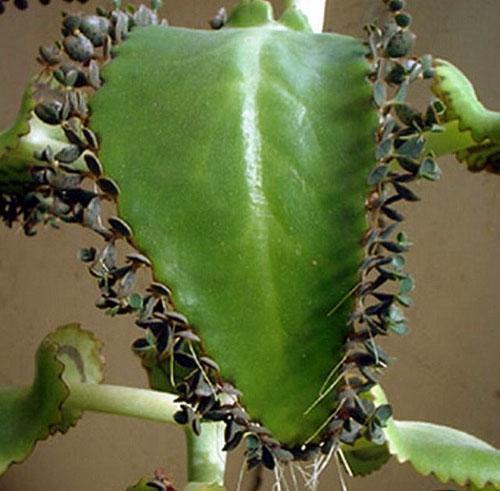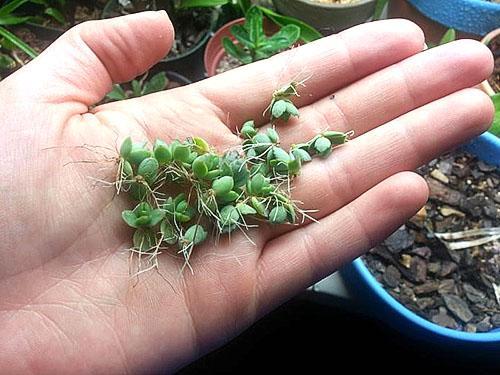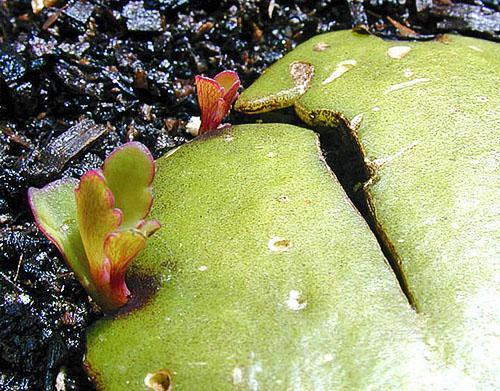Reproduction of Kalanchoe in different ways
 Kalanchoe refers to those plant species that are easy to reproduce in a variety of ways. Moreover, even an inexperienced grower can easily cope with this task. Kalanchoe, which can be propagated by seeds, babies, offspring, leaf and stem cuttings, belongs to the genus of succulents, which are characterized by rapid growth. For vegetative propagation of the plant, you can even use old, fallen leaves that take root easily.
Kalanchoe refers to those plant species that are easy to reproduce in a variety of ways. Moreover, even an inexperienced grower can easily cope with this task. Kalanchoe, which can be propagated by seeds, babies, offspring, leaf and stem cuttings, belongs to the genus of succulents, which are characterized by rapid growth. For vegetative propagation of the plant, you can even use old, fallen leaves that take root easily.
Reproduction of Kalanchoe by brood buds (children)

Reproduction by leaf blades
 Reproduction of Kalanchoe leaves is carried out at any time of the year. To do this, an adult leaf is cut off and planted in a pot with a well-moistened fertile substrate. Cover the leaf with a glass or jar. After a few days, the leaf takes root and a full-fledged plant is soon formed from it. For reproduction, parts of the leaf blade buried in the soil are often used. Young plants also develop rapidly from them.
Reproduction of Kalanchoe leaves is carried out at any time of the year. To do this, an adult leaf is cut off and planted in a pot with a well-moistened fertile substrate. Cover the leaf with a glass or jar. After a few days, the leaf takes root and a full-fledged plant is soon formed from it. For reproduction, parts of the leaf blade buried in the soil are often used. Young plants also develop rapidly from them.
If you don't want to cut off the leaves from an adult plant, fallen leaves that have not had time to dry are also suitable for reproduction. In order for them to quickly take root, they are placed in a glass of water. After the first roots appear on the leaves, they are transplanted into pots with a fertile substrate.
Reproduction of Kalanchoe by cuttings
 Kalanchoe, which can be propagated by cuttings during the formation of a bush or plant transplant, takes root in wet soil in just 2 weeks. For cuttings, strong shoots are chosen. They can be of any length, but it is best to shorten them to 6-8 cm. Most often, shoot tops are used for this, which are soft and juicy tissues. They are cut and planted in a moist fertile substrate or placed in a glass of water until roots appear. Young plants obtained from cuttings form a neat bush and are easy to form.
Kalanchoe, which can be propagated by cuttings during the formation of a bush or plant transplant, takes root in wet soil in just 2 weeks. For cuttings, strong shoots are chosen. They can be of any length, but it is best to shorten them to 6-8 cm. Most often, shoot tops are used for this, which are soft and juicy tissues. They are cut and planted in a moist fertile substrate or placed in a glass of water until roots appear. Young plants obtained from cuttings form a neat bush and are easy to form.
Cutting Kalanchoe helps to continue the life of your favorite plant species planted on flower bed and get a full-fledged indoor flower.
The Kalanchoe Blossfeld species, which is popular among flower growers, reproduces well by cuttings. Aerial roots are often formed on the shoots of this flowering succulent. Cuttings with air roots cut off from the mother plant root very quickly in moist soil. This Kalanchoe develops rapidly. The next year, a full-fledged flowering plant is obtained from it.
Reproduction of Kalanchoe by offspring
 Kalanchoe is sometimes propagated by the offspring of an adult plant. To stimulate their development, pinch the tops of the stems after the succulent has faded.After that, young offspring grow next to the mother plant, which they use for reproduction. When they reach 1/3 of the height of an adult plant, they are carefully separated from it, being careful not to damage the roots. The offspring are planted in pots with a peat-sandy substrate. Such shoots quickly take root and grow.
Kalanchoe is sometimes propagated by the offspring of an adult plant. To stimulate their development, pinch the tops of the stems after the succulent has faded.After that, young offspring grow next to the mother plant, which they use for reproduction. When they reach 1/3 of the height of an adult plant, they are carefully separated from it, being careful not to damage the roots. The offspring are planted in pots with a peat-sandy substrate. Such shoots quickly take root and grow.
Reproduction of Kalanchoe axillary buds
Some types of Kalanchoe are distinguished by the fact that after flowering and leaf fall, buds of new shoots appear in place of leaf sinuses, in appearance resembling cabbage heads. When they have a trunk of 1-2 cm, they are carefully cut off with a blade, and planted in a substrate containing a large amount of sand. After about a week, the axillary buds take root and grow actively.
Reproduction of Kalanchoe seeds
 Kalanchoe, which is most often reproduced at home in early spring, can also be obtained from seeds. They are distinguished by good germination. Before sowing them, prepare well-drained fertile soil. The temperature in the room intended for seed germination should not fall below 20 ° C. The seed is spread evenly over the wet soil. Then they are pressed down with a finger. The pot or box with seeds is covered with glass or foil.
Kalanchoe, which is most often reproduced at home in early spring, can also be obtained from seeds. They are distinguished by good germination. Before sowing them, prepare well-drained fertile soil. The temperature in the room intended for seed germination should not fall below 20 ° C. The seed is spread evenly over the wet soil. Then they are pressed down with a finger. The pot or box with seeds is covered with glass or foil.
Periodically, the glass or film is removed to ventilate the crops. Water them with a spray bottle with water at room temperature. Not the slightest drying out of the substrate should be allowed. The glass or film is removed after germination. Slightly grown seedlings dive, removing the weakest specimens. Young succulents are transplanted into pots filled with substrate.
Features of the reproduction of different types of Kalanchoe
 Kalanchoe, reproduction of which in its various species is carried out in different ways, has several main methods of reproduction:
Kalanchoe, reproduction of which in its various species is carried out in different ways, has several main methods of reproduction:
- brood buds (children): Dergemona, pinnate, tube-colored;
- leafy cuttings: all types with large fleshy leaves;
- cuttings: Blossfeld, Mangin;
- offspring: Blossfeld;
- axillary buds: paniculate-flowered;
- seeds: feathery, tomentose.
To root the Kalanchoe planting material, a mixture of humus, leafy earth, peat and sand (1: 1: 1: 0.5) is used. Also suitable for this purpose are special soil mixtures sold in specialized stores. At the bottom of the pots, a drainage layer of expanded clay or clay shards must be laid.